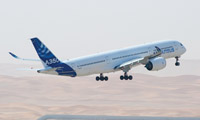News
Airbus decision about A380neo is in a HOLDING PATTERN
When more than 150 media flew into Toulouse last month for Airbus’ annual Innovation Days, the hosts sprung a surprise on their guests - and Emirates did the same with Airbus’ bosses.
July 1st 2014
The timing could hardly have been worse. With the global aviation press descending on its Toulouse headquarters for the company’s annual technical briefing, Airbus confirmed on the morning of the first day that major customer, Emirates Airline, had cancelled an US$16 billion order for 70 of its new A350s. Read More » “Not the world’s greatest news,” conceded the manufacturer’s chief operating officer customers, John Leahy.
Airbus president and CEO, Fabrice Bregier said: “Is it a problem for us? The answer clearly is no. But I do not like it because Emirates is a top class customer and I would prefer them to operate the A350.”
Surprise number two was an unscheduled one-hour flight over the Pyrenees and back to Toulouse on A350 MSN 4, one of the test aircraft.
 |
| Airbus' fifth and final A350XWB: flew its first flight in June |
The flight was a resounding success, apart from being a public relations master stroke. The general consensus was the A350, which Airbus says will produce a 25% reduction in operating costs compared with the current B777, would be an exceptional addition to the global airline fleet. Boeing is producing a B777X, which also will feature more fuel efficient engines.
First flight excitement aside, there were two questions that required answers. Will Airbus build a re-engined A330neo (new engine option) and is there going to be an A380neo? In both cases, Leahy replied: “We are studying it.” Brégier added: “It is under discussion.”
Airbus is being pressured by its biggest A380 customer, Emirates Airline, to upgrade the big jet to a neo version. The Dubai-based airline holds more than half of the A380 order book and chief executive, Tim Clark, has made it clear he would buy more of them if an A380neo was available.
“When your largest customer is encouraging you to study it, we will continue to study it. At present, we are not planning to [build] it. We have made no commitment to do so,” said Leahy. He added Airbus is reluctant to proceed with a new version of the plane for one customer.
As for the A330neo, the Toulouse manufacturer said it would be one airliner in a new family of the A330, with each of the aircraft’s type tailored for markets that ranged from short to medium to long-haul.
The twin aisle aircraft continues to sell well. At present, Airbus is particularly focused on marketing the “regional” version to Chinese carriers. Airbus said the A330 is perfectly suited for the networks of airlines where passenger numbers are expanding on short to medium-haul domestic routes. Airbus argues they need larger aircraft than single aisle planes.
Also critical for the company, Airbus said, is its commitment to “globalization”. Bregier wants the company perceived as global rather than European, a strategy that has gained momentum during his leadership.
From 2006 to 2012, Airbus revenue increased 50%, but sourcing to Asia quadrupled. At the end of this decade, Airbus said sourcing worldwide will be worth $60 billion and that up to 20% could be to Asia.
Airbus’ Tianjin, China A320 final assembly line has produced more than 170 aircraft, at the same quality as jets produced in France. Senior Airbus executives are not ruling out the possibility that one day an A330 assembly line could be set up in China, although they said it is not being discussed as yet.
Brégier said it is “inevitable” Airbus will continue on its trajectory of building a profile as a global company as its major enterprises in China and America grow. It also will develop its partnerships and joint ventures in India and elsewhere in Asia.
One of the most interesting discussions to emerge in Toulouse was the development of current philosophy at both Airbus and Boeing. It had been accepted thinking the next all-new passenger jet would be a new-design single-aisle plane to replace B737s and A320s. This is no longer the case.
Both manufacturers have opted for development programs with step changes to existing designs, rather than all-new aircraft. In essence, the A320neo and the B737 MAX are prolonging the lives of existing designs.
Brégier made it clear that when Airbus decided to replace the engines on its big earner, the A320 family, instead of developing a new aircraft, it was setting up Boeing for a race in which Airbus had fired the starting gun.
Boeing followed suit with its MAX, which confirmed the industry view that the next all-new single-aisle will not be flying until close to 2030.
Airbus also accepts it will eventually have to deal with more than Boeing as a competitor for business. Airbus vice president for international co-operation, Simon Ward, disagreed it was a risk to operate a final assembly line in China when the Chinese were working on their own mid size aircraft.
“If we did nothing in China would that stop China doing something in relation to airliners? No,” he said. Leahy added it was inevitable there would be competition from China, Japan and Russia and forecast such competition would not be really meaningful for some 25 years or more.”